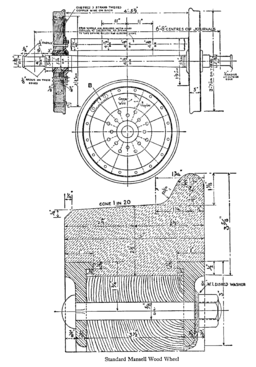
Mansell Wheel
Encyclopedia

The Mansell Wheel is a railway wheel patented by Richard Mansell
Richard Mansell
Richard Christopher Mansell was an English railway engineer.Mansell was carriage superintendent for the South Eastern Railway at Ashford by 1851, and later works manager for the SER. In 1877 he succeeded Alfred Mellor Watkin as locomotive superintendent of the SER...
, the Carriage and Wagon superintendent of the South Eastern Railway
South Eastern Railway (UK)
The South Eastern Railway was a railway company in south-eastern England from 1836 until 1922. The company was formed to construct a route from London to Dover. Branch lines were later opened to Tunbridge Wells, Hastings, Canterbury and other places in Kent...
in the UK.Dendy Marshall, C.F., History of the Southern Railway, Ian Allan 1963, ISBN 0 7110 0059 X The design was created in the 1840s and was eventually widely used on passenger railway stock in the UK. This is an interesting example of a composite wooden wheel, using the same principle as an artillery wheel
Artillery wheel
The artillery wheel was developed for use on gun carriages when it was found that the lateral forces involved in horse artillery manoeuvres caused normally-constructed cart wheels to collapse. Rather than having its spokes mortised into a wooden nave , it has them fitted together then bolted into...
but with a solid wooden centre instead of spokes. The drawing (right) is from an old railway design bookRailway Mechanical Engineering, a practical treatise by engineering experts, Volume 1. the Gresham Publishing Company Ltd. London, 1923. The design and construction of carriages and wagons section by S Warner Carriage and Wagon Superintendent London and South Western Railway. from the early 20th Century.
Overview
The reason for using wood was to reduce the noise. Having a wooden centre eliminated the ringing noise that emanated from early railway wheels. Made from teakTeak
Teak is the common name for the tropical hardwood tree species Tectona grandis and its wood products. Tectona grandis is native to south and southeast Asia, mainly India, Indonesia, Malaysia, and Burma, but is naturalized and cultivated in many countries, including those in Africa and the...
this type of wheel endured for a long time. Besides the reduction in noise there was an increased safety factor. While some of this might be attributed to the extra attention paid to what were specifically passenger carriage wheels, the potential for casting
Casting
In metalworking, casting involves pouring liquid metal into a mold, which contains a hollow cavity of the desired shape, and then allowing it to cool and solidify. The solidified part is also known as a casting, which is ejected or broken out of the mold to complete the process...
faults was also reduced.
The wooden centres acted as electrical insulators so Mansell wheels would not operate the track circuit
Track circuit
A track circuit is a simple electrical device used to detect the absence of a train on rail tracks, used to inform signallers and control relevant signals.- Principles and operation :...
s used in railway signalling. However, this problem was solved by fitting copper bonding
Bonding jumper
A bonding jumper is a reliable conductor to ensure the required electrical conductivity between metal raceways required to be electrically connected.-Components:...
to the wheels.

Colonel Stephens Railway Museum.
Re-use of wooden segments
The wooden segments of the wheel had a shorter life than other parts and so were replaced at intervals, usually because they had become loose in the wheel rim, not because the timber was otherwise damaged. This valuable teak was often re-used. As the segments were too short for most woodworking uses, they were typically re-used as wooden flooring blocks. These were particularly common for outdoor use in railway stations, around milk loading docks and platforms that handled postal traffic. These platforms were regularly in use overnight and the wooden blocks provided a quieter surface than cobblestones for the station's neighbours, even with iron-tyred carts running over them. An example of such a wood block pavement made from wheel segments survives at Liverpool's Edge HillEdge Hill railway station
Edge Hill railway station serves the district of Edge Hill in Liverpool, England.There have been two stations of that name. The first stood a short distance south-west of the present station and its remains are still visible, although the site is not open to the public.Edge Hill is the first...
.

